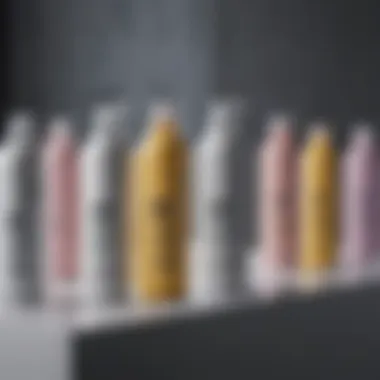Best Bleach for Hair Without Damage: Top Picks


Intro
Choosing the right hair bleach can feel like navigating a minefield, especially when one aims to achieve a lightened effect without causing damage. With various products on the market, it’s essential to decipher which options can effectively lighten hair while maintaining its health. This guide presents an in-depth exploration of the best hair bleach methods that prioritize damage reduction, tailored specifically for women of all ages.
The conversation around hair care has evolved significantly. More and more individuals are interested in the balance between aesthetics and the preservation of hair integrity. Here, we examine the types of products available, the chemistry behind them, and expert recommendations to ensure you engage in safe hair practices.
Understanding the nuances of bleaching products can empower consumers. By looking at user reviews, current trends, and safety tips, even those with previously damaged hair can navigate their way to vibrant results. As many women seek to express their unique styles through hair color, knowing how to do it responsibly is paramount.
Understanding Hair Bleaching
Understanding hair bleaching is crucial for anyone considering this process. Hair bleaching can significantly alter one’s hair color and style. This section aims to provide a solid foundation regarding what hair bleaching is, how it works, and the potential risks involved. Knowing these aspects can help users make informed decisions when selecting the best products that reduce damage.
What is Hair Bleaching?
Hair bleaching is a chemical process designed to lighten hair color. It works by using oxidizing agents, primarily hydrogen peroxide, which penetrate the hair shaft. This agent reacts with the melanin, the natural pigment in hair, breaking it down and resulting in a lighter shade. The process can vary in strength and duration, depending on the desired outcome.
Bleaching can be done in a salon or at home, but choosing the right method and products is essential for achieving optimal results without causing harm. The finish can range from subtle highlights to bold platinum locks, showing the versatility of the technique.
The Science Behind Hair Bleach
The chemistry involved in hair bleaching primarily revolves around oxidation. When the bleaching agent is applied, it interacts with the keratin structure of the hair. Here is a simple breakdown:
- Hydrogen peroxide functions by lifting the hair's natural color. It acts as an oxidizer, breaking down the melanin molecules.
- The strength of the bleach is measured in volumes, specifying how concentrated the hydrogen peroxide is.
- Higher volumes lead to quicker and more dramatic changes in hair color but increase the risk of damage.
This process can be sensitive, and understanding the right concentrations and formulations for different hair types is essential. This knowledge can prevent unwanted results, such as excessive dryness or breakage.
Why Hair Bleach Can Be Damaging
The appeal of a fresh hair color comes with consideration of the potential damage it can inflict on hair. Bleaching can lead to:
- Dryness and Fragility: The breaking down of melanin can also deplete moisture, leading to brittle hair.
- Loss of Elasticity: Over-bleaching can weaken the hair's structure, resulting in a lack of bounce and resilience.
- Scalp Irritation: Some users may experience sensitivity due to harsh chemicals, particularly if not applied correctly.
"Understanding the implications of hair bleach is vital for maintaining the integrity of your strands."
To minimize damage while still achieving desired results, it is necessary to carefully select hair bleaching products and strategies. The upcoming sections will delve deeper into the various types of bleaching products, offering recommendations for maintaining hair health throughout the bleaching process.
Types of Hair Bleaching Products
Understanding the different types of hair bleaching products is essential for selecting the right option for your needs. Each type has its own unique properties, application methods, and benefits. It's crucial to consider factors such as your hair type, desired results, and potential damage when choosing a product.
The linchpin to achieving effective hair lightening while minimizing damage lies in the formulation of the product. The choice between powder, liquid, or cream can significantly influence both the bleaching process and its outcome, making it imperative to obtain a thorough understanding of each type.
Powder Bleach
Powder bleach is a potent formula often used in professional settings. Typically, it comes in a fine powder form and must be mixed with a developer to activate its lightening properties. This type of bleach is known for its strong lifting abilities, which can be beneficial for those with darker hair colors seeking a significant change.
However, it does require skillful handling. The mixture's potency can lead to faster lightening and, consequently, higher risk of hair damage if not applied properly. Users should adhere strictly to time guidelines to prevent overprocessing.
Important Note: Using a high-quality developer can help control the strength of the bleach, hence reducing the potential for damage.
Liquid Bleach
Liquid bleach is another formulation that tends to have a thinner consistency than powder bleach. This type can easily spread through hair, making it easier to apply for some users. However, its effectivity may vary, as it might not provide the same level of lift as powder bleach. It can be particularly effective for root touch-ups, where precision is paramount.
One consideration is that liquid bleach often has a softer lightening action. This can be advantageous for those with sensitive hair or for first-time bleach users. Nevertheless, it's essential to ensure that hair is evenly saturated to achieve consistent results.


Cream Bleach
Cream bleach is often favored by at-home users. Its thicker consistency allows for better control during application, minimizing drips and ensuring even coverage. It is typically marketed as a gentler option, designed to respect the integrity of the hair while still lightening effectively.
Cream bleaches usually contain added moisturizers or ingredients that may help mitigate damage. They are suitable for those with fine or previously compromised hair, offering a balanced approach between effective bleaching and hair health.
In summary, when selecting a hair bleach product, consider your hair's specific characteristics and the results you wish to achieve. The differences among powder, liquid, and cream bleaches can significantly affect the overall outcome of your bleaching process.
Assessing Damage and Safety
Assessing damage and safety is critical when it comes to bleaching hair. This consideration is not merely a precaution; it is essential for ensuring the integrity and health of your hair. Understanding how your hair reacts to bleach helps prevent irreversible damage. Hair is often weakened when subjected to harsh chemicals, and assessing its condition can guide you to use the right products and techniques. Here, you will understand key elements in recognizing hair health, aligning bleach products with different hair types, and the importance of patch testing.
Recognizing Hair Health
Recognizing the current state of your hair is the starting point for any bleaching process. Healthy hair is resilient, reflective, and well-moisturized, while damaged hair may feel dry and brittle. Conducting a visual and tactile assessment can provide useful insights.
- Split Ends: If your hair shows visible split ends, it may need treatment before bleaching.
- Elasticity Test: Pull a strand of hair gently. Hair that stretches to a moderate degree and returns to its original length is generally healthy. If it breaks easily, it may not tolerate bleach well.
- Moisture Retention: Hydrated hair feels smooth. Dry hair can absorb moisture but lacks shine.
Taking time to assess these factors helps in making informed decisions about bleaching.
Compatibility with Hair Types
Each hair type has unique characteristics that influence how it reacts to bleach. Tailoring your approach based on these differences can enhance safety and outcomes. Different hair types include:
- Fine Hair: This type processes bleach quickly. Use lower volumes of developer to avoid over-processing.
- Medium Hair: It typically holds up well. Standard bleach products work best here.
- Thick Hair: Thick hair often requires more time for bleach to penetrate. Higher volumes may be necessary, but it's critical to monitor closely.
Understanding compatibility with your hair type will allow you to select products that minimize damage.
Patch Testing for Safety
Patch testing is a safety measure that should never be overlooked. It helps identify potential allergic reactions to bleaching chemicals. To perform a patch test:
- Apply a small amount of the bleach mixture behind your ear or on your inner elbow.
- Wait 24 to 48 hours for any reaction.
- If there is redness, itching, or irritation, do not proceed with the full treatment.
This small step can prevent serious adverse reactions and ensure that your hair bleaching experience remains as safe as possible.
Always prioritize safety when choosing to bleach. Your hair’s health influences both the process and the results.
Top Recommendations for Hair Bleach
When it comes to choosing hair bleach, the options can seem overwhelming. This section is crucial as it highlights trusted brands and important products that can effectively lighten hair without causing excessive damage. Understanding these recommendations is vital for achieving desired results while maintaining hair health. The focus here is on popular professional salon brands, user-friendly at-home kits, and organic or natural alternatives that align with safety and effectiveness considerations.
Professional Salon Brands
Professional salon brands are often considered the gold standard when it comes to hair bleaching. These products tend to have advanced formulations that are designed for optimal performance while minimizing damage. Brands like Schwarzkopf, Wella, and Redken are known for their quality offerings. These companies invest in research and development, creating formulas that mitigate the risks associated with hair bleaching.
When professionals use these products, they often recommend them based on the results they achieve in salons. This includes not only effective lightening but also preservation of hair integrity. Choosing a professional brand ensures that you are using products that have been tested and proven in various settings.
At-Home Hair Bleaching Kits
For those who prefer the convenience of at-home applications, there are several kits specifically designed for easy use while still being effective. L'Oreal Paris and Clairol provide popular options that offer clear instructions, necessary tools, and formulas intended to reduce potential damage.
Key benefits of at-home kits include:
- Convenience: No need to schedule appointments, offering flexibility.
- Cost-effective: Typically less expensive than professional services.
- Accessibility: Readily available at drugstores or online.
However, it is essential to follow instructions carefully and consider the condition of your hair before proceeding. Always look for kits that specify they are suitable for your hair type and desired results.
Organic and Natural Options


As awareness about beauty products grows, many consumers are turning towards organic and natural options for hair bleaching. Brands like Madison Reed and Oway provide formulations made from natural ingredients, reducing the risk of harsh chemicals damaging the hair. These products are designed not just for lightening but also for nourishing the hair during the process.
Using organic products offers several advantages:
- Fewer chemicals: This helps some individuals avoid potential scalp irritation.
- Sustainability: Many organic brands prioritize eco-friendly practices, which is appealing to environmentally conscious consumers.
- Healthier hair: Natural ingredients can promote better overall hair condition.
Techniques for Safe Bleaching
Bleaching hair can yield stunning results, but it also poses a risk to its health. This section emphasizes the need for safe techniques to mitigate damage. By understanding and implementing proper methods, one can achieve desirable colors without compromising hair integrity. Knowledge is key, and following certain practices ensures a more favorable outcome.
Correct Application Methods
Applying bleach correctly is crucial to prevent uneven results and minimize hair damage. Begin with clean, dry hair. Section the hair into manageable parts to ensure even distribution. Always start from the ends and move towards the roots. The roots tend to get warmer faster, which can accelerate the bleaching process. This can be beneficial, but also risky if not managed well. Using an applicator brush allows for precision. Make sure to apply a generous amount of bleach, ensuring saturation, but avoid excessive product, which could lead to clumping and unevenness.
Timing and Exposure Guidelines
Timing is another critical aspect of the bleaching process. Each product has a recommended processing time that should not be exceeded. Leaving bleach on for too long can lead to excessive damage and breakage. Check the hair every five to ten minutes after the initial application. If you notice the desired lightness, rinse immediately, regardless of the recommended time. Always follow the product instructions carefully. Remember, it’s easier to apply additional bleach later than to repair damaged hair.
Avoiding Overprocessing
Overprocessing is a common issue that happens when hair is bleached too frequently or when bleach remains on the hair for too long. To avoid this, limit bleaching sessions to every six to eight weeks. Give your hair time to recover between treatments. Incorporate nourishing hair masks and conditioning treatments during this period. If your hair feels dry or brittle during a bleaching process, stop immediately and assess the condition. Less is often more when it comes to achieving beautiful hair without losing its vitality.
"Proper techniques in bleaching are essential in ensuring hair remains healthy and beautiful. Adopting safe practices can lead to satisfying results without compromising hair quality."
By honing in on these key aspects of safe bleaching techniques, it becomes possible to significantly reduce the risks associated with hair bleaching while still achieving vibrant, beautiful colors. It is crucial to be diligent and attentive to both the application and care processes.
Post-Bleaching Care
After undergoing the hair bleaching process, appropriate post-bleaching care is crucial. It plays a significant role in maintaining hair health and integrity. Hair that has been bleached often suffers from dryness and weakened structure. It is essential to prioritize hydration, repair, and continual monitoring of hair condition to ensure vibrant results.
Rehydrating and Repairing Treatments
Using rehydrating and repairing treatments is vital post-bleaching. These treatments can restore moisture to the hair and alleviate damage caused by the bleaching process. Look for products that include ingredients like argan oil, keratin, and shea butter. These components nourish the hair, making it soft and manageable.
Consider applying deep conditioning masks once a week. They can provide intense hydration, helping to repair the hair's cuticle and improving overall health. Additionally, using leave-in conditioners can offer ongoing moisture throughout the day. This layered approach helps keep hair supple and strong, reducing brittleness and potential breakage.
Choosing Appropriate Hair Products
Selecting the right hair products after bleaching is essential. Avoid products with high alcohol content as they can exacerbate dryness. Opt for sulfate-free shampoos and conditioners, as they are gentler and help preserve hair color.
You might want to include protein-based products to help strengthen the hair structure. However, it's important to balance protein with moisture. An overload of protein can lead to stiff and fragile hair. Therefore, finding a good balance between moisturizing and strengthening products is key to maintaining health.
Monitoring Hair Health Over Time
Keeping an eye on the condition of your hair after bleaching is essential. Changes in texture, dryness, or breakage signal that a more tailored care routine may be needed. Regularly assess your hair's health by checking for signs of weakness.
You should also stay updated with periodic trims. Trimming split ends can vastly improve the appearance and health of your hair. Aim for a trim every six to eight weeks, depending on the texture and condition.
"Continuously monitoring your hair's response to treatments and products is key to long-term maintenance."
In summary, post-bleaching care is just as crucial as the bleaching process itself. By focusing on hydrating treatments, selecting the right products, and monitoring changes, you can effectively maintain healthy hair while enjoying its beautiful, lighter tones.
Expert Insights and User Experiences
Professional Stylist Recommendations


Professional stylists provide valuable insights based on their years of experience with various products. They often emphasize the importance of choosing a bleach that aligns with the client's specific hair type. Using brands like Wella Blondor or L’Oreal Quick Blue can offer a balance between effective lightening and minimizing damage. Stylists may also suggest following specific application techniques that can further reduce risks associated with bleaching.
Considerations from professionals also include understanding the formulations of the products. Different strengths of peroxide can lead to varying results. For instance, a lower volume developer might be beneficial for individuals with previously damaged hair. Ultimately, stylists recommend products that not only lighten hair but also nourish it during the process. This dual focus can lead to a healthier outcome after the bleaching.
User Reviews and Comparisons
User reviews serve as a real-world benchmark that highlights the pros and cons of various bleaching products. Individuals often share their personal journeys, detailing which products worked for them and which did not. These experiences are essential because they provide a diverse range of perspectives, from those with healthy hair conditions to people dealing with damage.
Comparisons made by users help others in deciding which product meets their unique needs. For example, a review may highlight how a specific brand like Clairol Professional develops shines and softness post-bleach. Alternatively, some users might discuss their struggles with a product that didn't achieve the desired results, prompting others to be cautious.
"User experiences can often reveal patterns that professional critiques may overlook, providing guidance that goes beyond mere marketing claims."
Common Mistakes to Avoid
Learning from others’ mistakes can be one of the best ways to ensure a safe bleaching process. Many users share common pitfalls they encountered during their hair bleaching journey. One of the most frequent errors is underestimating the importance of a patch test. A simple test can prevent severe allergic reactions and ensure the chosen product is suitable for the individual's hair.
Another common mistake involves improper timing. Users often report that they left the bleach on for too long, leading to unnecessary damage. Following manufacturer guidelines strictly can mitigate this risk.
In addition, users may disregard the necessity of proper post-bleaching care. Skipping repairs can lead to brittle hair, despite the initial intention to lighten it safely. Investing time in quality aftercare products can safeguard hair integrity after bleaching.
In summary, expert insights and user experiences foster a comprehensive understanding of the hair bleaching process. By synthesizing professional guidance with lived experiences, individuals can navigate the complex landscape of hair dyeing more effectively.
Culmination
Understanding the importance of proper hair bleaching techniques and products is crucial for maintaining healthy hair. The conclusion wraps up the key elements discussed throughout this article, emphasizing the various aspects that contribute to effective bleaching with minimal damage. In a world where beauty aesthetics are often prioritized, it’s vital to balance appearance with the health of one's hair.
Recap of Key Points
In summary, the following key points are essential for anyone looking to bleach their hair safely:
- Types of Hair Bleaching Products: The article dissected various product types, such as powder, liquid, and cream bleach, each having its own advantages and suitability for different hair types.
- Assessing Damage and Safety: Understanding one’s hair health and conducting patch tests can prevent adverse reactions and ensure compatibility with the chosen bleach.
- Expert Recommendations: Insights from professional stylists and user experiences offer valuable guidance on selecting the right products and avoiding common pitfalls.
- Post-Bleaching Care: Implementing aftercare procedures is critical for rejuvenating and maintaining hair vitality post-bleach.
By consolidating this information, readers can make informed decisions regarding hair bleaching.
Final Thoughts on Safe Bleaching
> Remember: Always prioritize the health of your hair above all else.
It is better to proceed with caution than to risk damage in pursuit of a temporary aesthetic change.
Help Sections
The FAQs section serves as a critical component of this article. It addresses common concerns regarding hair bleaching, making the information more accessible to readers. This part clarifies doubts and provides concrete answers, which can help demystify the process of bleaching hair safely. Knowing what to expect and understanding certain limitations are essential in minimizing potential risks associated with hair damage. The benefit of this section lies in its ability to preemptively answer reader questions, guiding them in their decision-making process.
How often can bleach my hair?
Bleaching hair is a significant process that alters its natural pigmentation. It is important to exercise caution regarding the frequency of bleaching. Generally, it is recommended to wait at least 6 to 8 weeks between bleaching sessions. This timeframe allows the hair to recover from the chemical process and prevents excessive damage. Some hair types, especially those that are already fragile or color-treated, may require even longer intervals. Monitoring your hair’s condition will help inform your decision.
Can bleach damaged hair?
Bleaching damaged hair is a risky endeavor and is typically not advised. If your hair is already weakened, the bleaching process can lead to further breakage or other undesirable effects. It is crucial to assess your hair’s health before proceeding. If damaged hair needs to be bleached, then first focus on repairing and strengthening it. Treatments, such as deep conditioning masks or bond-building treatments, can help restore some resilience, but even then, a patch test is vital to see how the hair reacts.
What to do if my hair becomes damaged?
Encountering damage after bleaching can be disheartening. If damage occurs, immediate action is necessary. First, stop using any harsh chemicals and avoid heat styling tools. Transition to gentler hair care products designed for damaged hair. Deep-conditioning treatments or protein reconstructors can assist in rebuilding the hair's structure.
- Assess the damage and determine its severity.
- Adjust your hair care routine, focusing on hydrating treatments.
- Consider consulting a professional stylist who can provide tailored advice suitable for your hair type.
- In extreme cases, strategically trimming the most damaged ends may be necessary to promote healthy growth.
"Prevention is preferable to treatment. Always prioritize your hair health before pursuing more appearances."
Understanding each of these points will help readers navigate their hair bleaching journey more confidently, ensuring they maintain overall hair health while achieving desired looks.
For further knowledge, explore reliable sources such as Wikipedia or Britannica.



